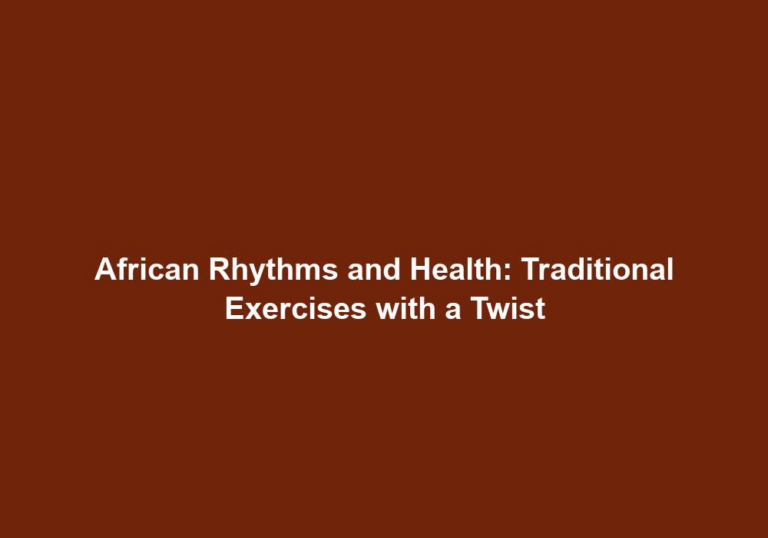Cardiovascular Fitness: Aerobic or Anaerobic – Which Wins?
Introduction
When it comes to cardiovascular fitness, there is often a debate about which type of exercise is more beneficial – aerobic or anaerobic. Both forms of exercise have their own unique advantages and can contribute to overall fitness levels. In this article, we will explore the differences between aerobic and anaerobic exercise, their benefits, and how they can be incorporated into a well-rounded fitness routine.
Aerobic Exercise
Aerobic exercise, also known as cardio exercise, refers to any form of exercise that increases the heart rate and stimulates the cardiovascular system over an extended period. This type of exercise relies primarily on oxygen to produce energy and is typically performed at a moderate intensity level. Examples of aerobic exercises include jogging, swimming, cycling, and dancing.
Benefits of Aerobic Exercise
-
Improved cardiovascular health: Regular aerobic exercise strengthens the heart and improves its efficiency, leading to a reduced risk of heart disease, high blood pressure, and stroke. It helps to lower cholesterol levels and improve blood circulation.
-
Weight management: Aerobic exercise is an effective way to burn calories and maintain a healthy weight. It helps to increase the body’s metabolic rate, leading to the burning of stored fat. It is important to note that a combination of aerobic exercise and a balanced diet is key to achieving weight loss goals.
-
Increased lung capacity: Aerobic exercise enhances the ability of the lungs to take in and utilize oxygen, improving overall respiratory function. It helps to strengthen the respiratory muscles and can be particularly beneficial for individuals with respiratory conditions such as asthma.
-
Mental well-being: Engaging in aerobic exercise releases endorphins, which are known as feel-good hormones. This can help reduce stress, anxiety, and symptoms of depression. It promotes a positive mood and can enhance cognitive function.
-
Improved sleep quality: Regular aerobic exercise can help regulate sleep patterns and promote a deeper, more restful sleep. It can reduce the occurrence of sleep disorders such as insomnia and improve overall sleep quality.
-
Increased endurance: Aerobic exercise improves the body’s endurance by increasing the efficiency of oxygen utilization and energy production. This allows individuals to engage in physical activities for longer durations without experiencing excessive fatigue.
-
Lowered risk of chronic diseases: Regular aerobic exercise has been associated with a reduced risk of chronic diseases such as type 2 diabetes, certain types of cancer, and metabolic syndrome. It helps to improve insulin sensitivity and overall metabolic health.
Anaerobic Exercise
In contrast to aerobic exercise, anaerobic exercise involves intense bursts of activity over a short period. This type of exercise relies on energy sources stored in the muscles rather than oxygen. Examples of anaerobic exercises include weightlifting, sprinting, high-intensity interval training (HIIT), and plyometrics.
Benefits of Anaerobic Exercise
-
Increased muscle strength and power: Anaerobic exercise stimulates the growth and development of muscle fibers, leading to improved strength and power. This can be particularly beneficial for athletes and those looking to enhance their physical performance. It helps to build lean muscle mass and improve overall body composition.
-
Enhanced metabolism: Anaerobic exercise increases the body’s metabolic rate, leading to a higher calorie burn, even at rest. This can aid in weight management and the development of lean muscle mass. It also helps to increase post-exercise oxygen consumption, resulting in a greater calorie burn after the workout.
-
Improved bone density: Engaging in weight-bearing anaerobic exercises like weightlifting can help increase bone density and reduce the risk of osteoporosis. It puts stress on the bones, stimulating them to become stronger and denser over time.
-
Elevated anaerobic threshold: Regular anaerobic training improves the body’s ability to tolerate and recover from high-intensity exercise. It helps to delay the onset of lactic acid buildup and fatigue, allowing individuals to perform at higher intensities for longer durations.
-
Increased power and speed: Anaerobic exercise enhances the body’s ability to generate power and speed. It improves explosive strength and quickens reaction times, making it beneficial for sports that require bursts of speed and agility.
-
Boosted growth hormone production: Anaerobic exercise stimulates the production of growth hormone, which is essential for muscle growth, tissue repair, and overall development. This can aid in muscle recovery and promote muscle hypertrophy.
Balancing Aerobic and Anaerobic Exercise
While both aerobic and anaerobic exercise offer unique benefits, it is essential to strike a balance between the two for optimal fitness. Incorporating a combination of both types of exercise into your routine can help achieve overall cardiovascular fitness and improve overall health.
Tips for Balancing Aerobic and Anaerobic Exercise
-
Set clear fitness goals: Determine whether your primary objective is to improve endurance, lose weight, build muscle, or enhance overall fitness. This will help you prioritize the type of exercise you engage in. Tailor your workouts to align with your goals.
-
Create a weekly schedule: Plan your workouts in advance, ensuring that you have a mix of both aerobic and anaerobic exercises throughout the week. This will help you stay consistent and avoid overtraining in one area. Allocate specific days for each type of exercise or incorporate hybrid workouts that combine elements of both.
-
Vary your workouts: Incorporate a variety of aerobic and anaerobic exercises to keep your routine interesting and challenge different muscle groups. This can also prevent plateaus and promote continuous progress. Experiment with different types of aerobic exercises (e.g., running, swimming, cycling) and try various anaerobic exercises (e.g., weightlifting, HIIT, plyometrics) to keep your body and mind engaged.
-
Listen to your body: Pay attention to how you feel during and after workouts. If you experience excessive fatigue or muscle soreness, it may indicate the need for rest or a change in exercise intensity. It’s important to give your body adequate time to recover between intense anaerobic workouts to prevent overtraining and minimize the risk of injury.
-
Consider professional guidance: If you are new to exercise or unsure about how to balance aerobic and anaerobic workouts effectively, consulting with a fitness professional can provide valuable guidance and personalized recommendations. They can help design a customized workout plan that aligns with your goals, fitness level, and lifestyle.
Conclusion
In the debate between aerobic and anaerobic exercise, both forms have their merits and contribute to overall cardiovascular fitness. Aerobic exercise improves cardiovascular health, aids in weight management, enhances lung capacity, and promotes mental well-being. On the other hand, anaerobic exercise increases muscle strength, elevates metabolism, improves bone density, and boosts power and speed. By striking a balance between the two and incorporating them into a well-rounded fitness routine, individuals can experience the benefits of both types of exercise and achieve optimal overall fitness. So, whether you prefer a heart-pumping jog or a challenging weightlifting session, remember that cardio and strength training can go hand in hand on your journey towards better health and wellness.







